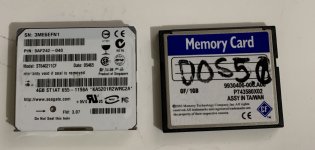blackepyon
Veteran Member
That's probably good enough, then.
Those Unigen cards really screwed me. I probably would have noticed how flaky they were sooner and made the connection if I'd set them up from scratch in the machines and *hadn't* also been in the middle of general hardware QA on the new boards. But instead I got the "brilliant" idea, since they were just exactly the right size to do it and the cards seemed nifty and fast, of using DD on the unix box to clone the working DOS install I had on the CF-SD adapter over to the pair of 2gig cards. Despite how obviously flaky they look under the microscope the fact that they flip bits on the regular can *mostly* go unnoticed, or at least not be obvious to pin on the CF card. Stuff will just crash at random well after it was loaded into memory and you'll pull your hair out and start howling about what *must* be wrong with your RAM board. Sigh.
I wonder how many Cisco cards are just badged from other brands. It doesn't surprise me at all that this happens, but I wonder if they've got multiple brands under those labels and some of them might work better than others.

